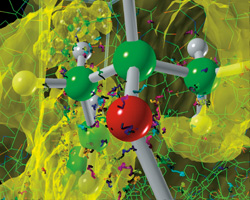
Energy Technologies and Environmental Studies, page two
Berkeley Lab is leading a multi-institutional initiative, called SECUREarth, which will accelerate the study of subsurface processes that impact water resources, environmental remediation, agriculture, energy production, and climate change. The program’s mission is to ensure energy security and environmental protection.
“To meet tomorrow’s demands, we need a quantum leap in our understanding of subsurface processes — and SECUREarth can help us do that,” says Gudmundur “Bo” Bodvarsson, director of Berkeley Lab’s Earth Sciences Division and one of the architects of the program.

Scientists are using supercomputers at the National Energy Research Scientific Computing Center (NERSC) to calculate and visualize the electronic structures of key molecules involved in the complex reactions of photosynthesis.
SECUREarth scientists will harness powerful scientific tools such as deep earth imaging and supercomputers to focus on two broad problems. The first is how best to clean up and isolate subsurface waste, whether it’s existing waste such as at the Hanford Site in Washington state, or potential waste, such as at the proposed Yucca Mountain nuclear waste repository. The second problem concerns how to most efficiently locate and extract the subsurface resources that drive the nation’s economy. These include methane hydrates, oil and gas, geothermal energy such as hot water and steam, and water for agriculture, power plants, and drinking needs.
Berkeley Lab scientists are also seeking ways to make fuel and electricity directly from sunlight in an effort to create energy without emitting carbon into the atmosphere.
One option is to mimic nature. Through photosynthesis, green plants are able to harvest energy from sunlight and convert it to chemical energy. If scientists can create artificial versions of photosynthesis, the dream of solar power as a clean, efficient and sustainable source of energy for humanity could be realized.
But photosynthesis is a complex process. Fortunately, an important piece of the photosynthesis puzzle is now in place. Researchers with Berkeley Lab and UC Berkeley have identified one of the key molecules that help protect plants from oxidation damage as the result of absorbing too much light. The researchers determined that when chlorophyll molecules in green plants take in more solar energy than they are able to immediately use, molecules of zeaxanthin carry away the excess energy. This study was led by Lab Deputy Director Graham Fleming and Kris Niyogi, who holds a joint appointment with Berkeley Lab and UC Berkeley.
If scientists can learn to emulate nature’s technique and create artificial versions of photosynthesis, then people could effectively tap into the sun as a clean, efficient, sustainable and carbon-neutral source of energy.
Another promising clean energy idea is a new generation of solar cells that combine nanotechnology with plastic electronics. Such hybrid solar cells will be cheaper and easier to make than their semiconductor counterparts.
“We have demonstrated that semiconductor nanorods can be used to fabricate readily processed and energy-efficient hybrid solar cells together with polymers,” says Paul Alivisatos, a chemist who holds a joint appointment with Berkeley Lab’s Materials Science Division and UC Berkeley.
Berkeley Lab scientists are also world leaders in learning how to sequester carbon dioxide deep underground and in the ocean, where it can’t wreak havoc on the Earth’s climate. It’s estimated that each year seven billion tons of carbon dioxide enter the atmosphere through the burning of fossil fuels.